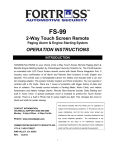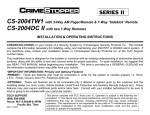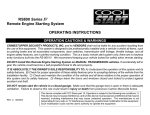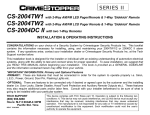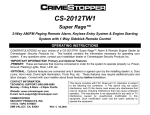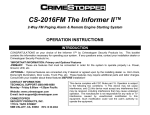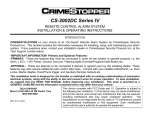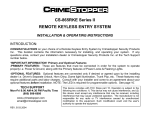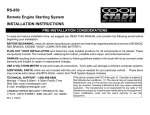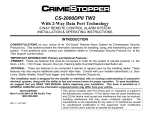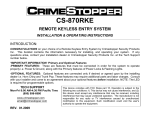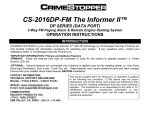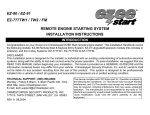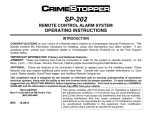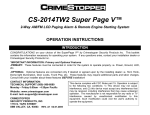Download CrimeStopper CS-2004.TW1.I Operating instructions
Transcript
CS-2004TW1 with 2-Way Paging Remote & 1-Way ‘Sidekick’ Remote CS-2004DC with two 1-Way Remotes INSTALLATION & OPERATING INSTRUCTIONS CONGRATULATIONS on your choice of a Security System by Crimestopper Security Products Inc. This booklet contains the information necessary for installing, using, and maintaining your 2004TW1 or 2004DC alarm system. If any questions arise, contact your installation dealer or Crimestopper Security Products Inc. at the Tech Support number below. This installation book is designed for the installer or individual with an existing understanding of automotive electrical systems, along with the ability to test and connect wires for proper operation. To ease installation, we suggest that you READ THIS MANUAL before beginning your installation. This book is provided as a GENERAL GUIDLINE and the information contained herein may differ from your vehicle. *IMPORTANT INFORMATION: Primary and Optional Features -PRIMARY: These are features that must be connected in order for the system to operate properly i.e. Siren, L.E.D., Power, Ground, Door Pin, Flashing Lights etc. -OPTIONAL: These are features are to be connected only if desired or agreed upon by the customer and the installing dealer (i.e. Door Locks, Starter Disable, Hood/Trunk Protection and Auxiliary Remote Outputs etc.) These features may also require additional parts and/or labor fees. Consult with your installer beforehand to be sure of what is going to be installed with your particular system. TECH SUPPORT (800) 998-6880 Hours: M-F 8:00AM-4:30PM Pacific Std. Time REV A 7.2003 This device complies with FCC Rules part 15. Operation is subject to the following two conditions: 1) This device may not cause interference, and (2) this device must accept any interference that may be received, including interference that may cause undesired operation. The manufacturer is not responsible for any radio or TV interference caused by unauthorized modification to this equipment. Such modification could void the user's authority to operate the equipment. TABLE OF CONTENTS Installation Cautions & Warnings…….………………………………………………………………...………………2 Suggested Component Mounting………….……………………………………………………………….…………..3 Wiring……..……………………………………………………………………………………………………………….3-5 Power Door Lock Wiring...………………………………………………………………..……………………………6-7 Starter Disable Wiring…………………………..…..……………………………………………………………..……..8 System Wiring Diagram………………….……………………………………………………………………….………9 CS-2004TW1 Antenna Diagram………...……………………………………………………………………….…..…10 Option Programming……………..………………………………………………………………………..…….……11-13 Programmable Option Reset………………………...……….………………………………………………………...13 Transmitter Programming……..……………………………………………………..………………………..…….13-14 Operation………………………………..………………………………..……………………….………………..…..15-19 Carjack Operation………………………………………………………………………………..……..……………..19-20 INSTALLATION CAUTIONS & WARNINGS BEFORE BEGINNING, check all vehicle manufacturer cautions and warnings regarding electrical service (AIR BAGS, ABS BRAKES, AND BATTERY). TO PREVENT A POSSIBLE DEAD BATTERY remove vehicle dome light fuse while working on the vehicle. MAKE CERTAIN TO REINSTALL FUSE PRIOR TO TESTING FOR DOOR TRIGGERS. DO NOT EXCEED MAXIMUM OUTPUT RATINGS! - SERIOUS DAMAGE MAY OCCUR. LIMITS FOR ALARM FUNCTIONS ARE LISTED WHERE APPLICABLE. REMOVE MAIN SYSTEM FUSE(S) before jump starting the vehicle or charging the battery at high boost. DAMAGE MAY OCCUR TO SYSTEM IF PROPER PRECAUTIONS ARE NOT OBSERVED. DO NOT ROUTE ANY WIRING THAT MAY BECOME ENTANGLED with brake, and gas pedals, steering column, or any other moving parts in the vehicle. 2 CONTROL MODULE / COMPONENT MOUNTING DO NOT Mount the control unit or wiring harness in the engine compartment or anywhere they can become entangled with moving parts such as brake/gas/clutch pedals, or the steering column. The alarm control module should be mounted in a concealed location. The antenna wire should be routed away from any metal if possible. Do not alter the length of the antenna, ground it, or route it with other wires. SIREN MOUNTING: Mount the siren under the hood to fender-well or other body surface with the open end facing downward. Run the red siren wire through the firewall using a rubber grommet. Ground the black wire to the body. LED: Mount the red LED in a visible location on the dashboard or console. Shock Sensor: Mount the included shock sensor with wire ties to an under dash wire harness or fasten with screws to firewall or side paneling. Override/Program Button: Mount the Override/Program push-button in a hidden but accessible location. It is used for emergency disarm without the use of the transmitter and for programming certain features. WIRING RED WIRE: +12V POWER INPUT (15 Amp Fuse) Connect to a +12 Volt source with the supplied fuse and fuse-holder. We recommend the connection to be at the Vehicle’s Battery Positive Terminal. BLACK WIRE: CHASSIS GROUND THIS WIRE MUST BE CONNECTED TO THE CHASSIS METAL OF THE VEHICLE. Scrape away any paint or dirt to ensure a good connection. YELLOW WIRE: IGNITION SWITCHED “ON” and “START” +12 VOLTS Connect to a (+) Ignition wire that shows +12 Volts when the key is in both the “ON” and “Cranking” positions. ORANGE WIRE: (-) NEGATIVE ARMED OUTPUT This wire becomes a Negative Ground output when system is armed. This output can be used for additional starter disable relays or to activate other devices such as scanner LED’s, window modules, voice modules etc. WHITE WIRE: +12V FLASHING PARKING LIGHT OUTPUT (Optional) Connect to switched parking light wire at back of light switch or connect directly to one of the parking lights at the front of the vehicle. European vehicles may require additional parts due to separate left and right circuits. BROWN WIRE: (+) SIREN OUTPUT (3 Amp Max.) Connect to the siren’s RED wire. Connect the Siren’s Black Ground wire to the chassis close to the siren. 3 WIRING BLUE WIRE: (-) HOOD/TRUNK TRIGGER The Blue wire is used for a grounding hood pin switch, trunk pin or both. Connect to existing hood and trunk pin switches that read ground when open. If no existing switches are available, install new pin switches if desired. GREEN WIRE: (-) DOOR TRIGGER Connect to Negative type door switches that read ground when a door is opened and 12 volts when all doors are closed. In the case of isolated door triggers, you may need to run additional wires from other doors OR go directly to the dome light. VIOLET WIRE: (+) DOOR TRIGGER Connect to Positive type door switches that show +12 Volts when the door is open and Ground when the doors are closed. GRAY WIRE: (-) AUX. OUTPUT #1 OR M.A.P.-Mobile Accessories Protection (Optional, requires relay) This is a programmable output wire that can operate two different ways: 1. (DEFAULT Operation) A Remote Auxiliary Output that provides a ½ Second (-) Negative pulse when Button #3 is pressed and released to open a power trunk or hatch release. Connect this wire to terminal 85 of a relay to operate AUX device or function. Connect terminal 86 or the relay to +12 Volts constant. Connect terminal 87 to 12Volts or Ground depending to the type of circuit needed. Connect Terminal 30 to the AUX device’s activation wire. 2. (MAP Operation) Provides a continuous (-) Negative output when in the alarm system is put into VALET PARK MODE. This can be used to interrupt accessory wire of the vehicle preventing unauthorized use of the vehicle’s audio or entertainment systems when VALET PARK MODE is ON, hence the name “MAP – Mobile Accessory Protection”. See Mobile Accessories Protection Diagram below. Relay not included 86 85 GRAY Connect relay as shown to interrupt the power wire of mobile accessories such as Audio system or Video monitors. The Alarm will disconnect these accessories when in VALET PARK MODE. 87 87A 30 OFF KEY CUT 105.5 ACC IGN MOBILE ACCESSORY PROTECTION FM SIDE START 4 RADIO, etc. WIRING WHITE/RED WIRE: (-) REMOTE OUTPUT #2 (Optional, Requires Relay) This wire provides a momentary (-) Negative auxiliary Output when Button #4 is pressed and held for at least 2 seconds. Connect this wire to terminal 85 of a relay to operate an AUX device or function. Connect terminal 86 or the relay to +12 Volts constant. Connect terminal 87 to 12Volts or Ground depending to the type of circuit needed. Connect Terminal 30 to the AUX device’s activation wire. This output will stay activated as long as the button is held down. PINK WIRE: (+) CARJACK INPUT Connect to a push button, toggle switch, or to a +12 Volt source to selectively activate Car Jack protection features - See diagram on next page for example wiring configuration. This wire is used to activate a passive carjack trigger even if the Carjack features are not turned on in the programming options. A Carjack countdown will begin under the following conditions: Ignition is ON (vehicle is running), the button or toggle switch is pressed, and a door opens & closes. Upon these 3 events, in that order, the alarm will start a Carjack countdown. See “Carjack protection” section on page OPTIONAL CAR JACK WIRING: SWITCH HIDDEN BUTTON or TOGGLE SWITCH (Not Included) PINK 2-PIN PLUG (SMALL): LED INDICATOR (RED FLASHING LIGHT) 2-PIN PLUG (MEDIUM): PROGRAM/OVERRIDE PUSH BUTTON TIP: The Sensor supplied with 4-PIN SENSOR PLUG: RED WIRE SENSOR +12V POWER BLACK WIRE SENSOR GROUND BLUE WIRE: NEG. WARN AWAY WHITE WIRE: NEG. TRIGGER this system does not require any additional wiring, simply mount the sensor in a suitable location, plug in, and adjust to the desired levels of sensitivity. The Black dial is for Pre-warn level and White dial is for Shock trigger. 3-PIN BLUE SENSOR #2 PLUG: (For adding additional sensors) PIN 1: SENSOR +12V POWER PIN 2: NEGATIVE (-) TRIGGER PIN 3: SENSOR GROUND 5 + +12 V POWER DOOR LOCK WIRING 6-PIN DOOR LOCK PLUG 18 GA. (Optional / ON-Board Relays): VIOLET: WHITE: GRAY: VIO/WHT: GREEN: BLUE: DOOR LOCK Relay Term. #87: DOOR LOCK Relay Term. #30: DOOR LOCK Relay Term. #87A: DOOR UNLOCK Relay Term. #87: DOOR UNLOCK Relay Term. #30: DOOR UNLOCK Relay Term. #87A: Normally Open [Polarity Input for Lock relay] Common [Lock Output] Normally Closed Normally Open [Polarity Input for Unlock relay] Common [Unlock Output] Normally Closed DETERMINING DOOR LOCK TYPE: We recommend determining the type of locking system the vehicle has before connecting any wires. Incorrect connection may result in damage to the alarm and/or vehicle locking system. This door lock information is provided as a guide. Your vehicle may differ. Negative Trigger (-): Many Imports; Late model Ford & General Motors Negative trigger door lock systems send a Negative (Ground) pulse to existing factory relays to lock and unlock the vehicle doors. Positive Trigger (+): Many General Motors; Chrysler / Dodge / Plymouth Positive trigger door lock systems send a Positive (+12V) pulse to existing factory relays to lock and unlock the vehicle doors. Reverse Polarity: Many Ford/Lincoln/Mercury/Dodge/Chrysler/Plymouth and early 90’s GM Trucks Reverse Polarity systems use no relays, but instead the door lock/unlock motors are controlled directly from the lock and unlock switches in the door. The lock and unlock wires rest at Negative Ground when not in use. When the lock or unlock button is pressed, one of the circuits is “Lifted” and replaced with +12V causing a lock or unlock to happen. Single Wire (Dual Voltage): Late model Chrysler/Dodge/Plymouth Vehicles, some 2000-UP GM Dual Voltage systems have lock/unlock switches that send varying amounts of Positive voltage OR Negative ground current to the SAME wire for both lock and unlock. When the vehicle’s Body Computer Module (BCM) or door lock module senses different voltages on this wire, the system will either lock or unlock. Single wire door lock systems require relays and resistors. Databus Systems (2003 GM Trucks & SUV’s, ‘99-04 Jeep Grand Cherokee Databus systems send low current “Data messages” to the door lock controllers in order to lock and unlock the vehicle. To install aftermarket systems in these vehicles, an interface module is required that converts the regular lock/unlock pulses into “Data messages” to allow locking & unlocking. Interface modules are sold separately. 6 POWER DOOR LOCK DIAGRAMS POSITIVE TRIGGER DOORLOCK WIRING NEGATIVE TRIGGER DOORLOCK WIRING BLUE X X= GREEN X= NOT USED GREEN VIOLET/WHITE GRAY X BLUE NOT USED VIOLET/WHITE X X GRAY WHITE WHITE VIOLET VIOLET +12V + FUSED L FACTORY LOCK WIRE L LOCKING UL UNLOCK WIRE UL RELAYS UNLOCK WIRE FACTORY LOCKING RELAYS AFTERMARKET MOTOR DOOR LOCK WIRING REVERSE POLARITY DOOR LOCK WIRING BLUE BLUE GREEN GREEN VIOLET/WHITE VIOLET/WHITE GRAY GRAY WHITE WHITE VIOLET VIOLET +12V + FUSED +12V FUSED + LOCK WIRE UL L CUT CUT UL + UNLOCK WIRE L LOCK WIRE 7 STARTER DISABLE WIRING STARTER DISABLE PLUG: 3 ORANGE 14 GA. WIRES: (PROGRAMMABLE: Normally Closed or Normally Open Configuration with ON-Board Relay) Note: READ BELOW before connecting starter disable! Normally OPEN must be programmed to operate. See pg 10. Normally Closed Starter disable is the standard type used with most alarm systems today. This circuit will disable the Starter while the alarm is armed or has been triggered. If 12V power is removed from the system, the Battery goes dead, the relay will revert back to the closed position. (Factory Default) Normally Open Starter Disable is a High-Security circuit that will disable the starter while the alarm is armed or triggered AND if the unit is unplugged or removed from power. This means that if the vehicle’s Battery goes dead or the unit is unplugged from the vehicle, the car will still not start. We only recommend this type of circuit if you can install a hidden highcurrent toggle switch to defeat the Normally Open disable in case of a dead battery or if the unit is unplugged/remove for service. (Toggle not included) See programming option #13 on page 10 to enable this type of starter disable. NORMALLY CLOSED STARTER DISABLE (DEFAULT) IGN SWITCH START WIRE CUT STARTER N/C ORANGE ORANGE COM ORANGE N/O NOTE ALIGNMENT OF PLUG N/C = NORMALLY CLOSED NORMALLY OPEN STARTER DISABLE (OPTIONAL) IGN SWITCH CUT START WIRE N/C ORANGE ORANGE COM ORANGE N/O **JUMPER #7 MUST BE REMOVED!** STARTER NOTE ALIGNMENT OF PLUG N/O = NORMALLY OPEN 8 HIDDEN TOGGLE SWITCH (NOT INCLUDED) SYSTEM WIRING DIAGRAM POLARITY SELECT LOCK(87) LOCK OUTPUT(30) LOCK SWITCH(87A) POLARITY SELECT UNLOCK(87) UNLOCK OUTPUT(30) UNLOCK SWITCH(87A) CUT STARTER IGNITION SWITCH 87 85 30 86 87 85 30 86 87 85 30 86 N/O (-)DOME LIGHT STARTER DISABLE (-)REMOTE OUTPUT 2 VIOLET WHITE GRAY VIO/WHT GREEN BLUE N/O COMMON N/C N/C BLACK/WHITE BLACK 3-PIN CS-2004TW1 Antenna CS-2004TW1 CS-2004DC WHITE/RED (-)REMOTE OUTPUT 1 GRAY + CAR-JACK ENABLE PINK + DOOR TRIGGER VIOLET (-)DOOR TRIGGER SWITCH GREEN (-)HOOD/TRUNK TRIGGER SWITCH BLUE BROWN SIREN PARKING + 2A MAX WHITE BROWN OPTIONAL SENSOR 2 + 10A MAX (-) ARMED OUTPUT LIGHTS ORANGE (-) 500MA YELLOW + SWITCHED IGN "ON" IGNITION SWITCH BLUE 3-PIN (NOT USED) BLACK GROUND FUSE - + RED BATTERY BATTERY VALET/ PROGRAM SWITCH DUAL-STAGE SHOCK SENSOR LED 9 CS-2004TW1 ANTENNA The following diagram pertains to the CS-2004TW1 model only: WINDSHIELD CS-2004TW1 Antenna System RECOMMENDED ANTENNA LOCATIONS Window Mount Antenna Transceiver Box Blue Plug Note Orientation of Black & Blue Plugs. Colors must match, or system will not operate! Black Plug 10 CS-2004TW1 OPTION PROGRAMMING To Engage Option Programming: 1. Turn Key to the ON position and wait 5 seconds. 2. Press program / valet button 5 times, after a few seconds the unit will flash the lights 5 times and the LED will light solid. 3. Push the valet/program button [again] the number of times that corresponds to the option number desired (1 thru 13). Press so that you get a light flash after each button press. If the unit did not flash the lights, then it did not register your press. See chart below for option list. 4. When you reach the desired programming level, Press button #1(Lock) or #2 (Unlock) to change the option. Pressing button 1 will provide one light flash and pressing Button 2 will provide 2 light flashes. 5. Turn Ignition OFF and check for changed features. Change each option individually repeating steps #1-5. * =Factory Default Value Option # 1 2 3 4 5 6 7 8 9 10 11 12 13 14 Option Description Auto lock with Ignition Passive Arming Active Re-Arm Passive Locks Parking Lights on w/Disarm GRAY wire programming Type of Carjack protection: Active or Passive Carjack Disarm on Trunk pop Open Door Warning Door Lock Pulse Time Double Unlock Pulse Enable / Disable Carjack Features Starter Disable Relay Config. Option reset Lock Button #1 OFF ON ON ON OFF M.A.P. On in Valet Park Passive Unlock Button #2 *ON *OFF *OFF *OFF *ON *Trunk Pop (Aux. #1) *Active OFF 5 Sec. 3 Sec. 2 Pulses Enable Normally Open *ON *60 Sec. *0.75 Sec. *1 Pulse *Disabled *Normally Closed Reset options 1. AUTOLOCK WITH IGNITION This option controls whether the doors will automatically lock when the ignition is turned on and will unlock when the ignition is turned off. 11 OPTION PROGRAMMING 2. PASSIVE ARMING This option controls the Passive (Automatic) arming feature. If ON, arming will occur 30 Seconds after the ignition is turned off and the last door has been closed. The LED will begin flashing rapidly. If a door is reopened, the system will wait (LED solid) for the door or zone to close before arming. 3. ACTIVE RE-ARM Active Re-arming allows the system to re-arm itself 30 seconds after disarmed with the transmitter if a door has not been opened. This is handy if the vehicle is accidentally disarmed without your knowledge. 4. PASSIVE LOCKS This option controls whether the doors will also lock when Passive Arming occurs. Note: May increase the risk of locking keys in the vehicle. 5. PARKING LIGHTS ON WITH DISARM Keeps parking lights on when system is disarmed to assist in locating and providing illumination near your vehicle when approaching at night for safety. 6. GRAY WIRE PROGRAMMING: TRUNK POP (AUX 1) or M.A.P. OUTPUT This option controls whether the system’s GRAY wire functions as Remote Aux. Output 1, or as an Output for (MAP) Mobile Accessories Protection. Mobile accessory protection activates only in Valet Park Mode. See page 4. 7. TYPE of CARJACK PROTECTION (ACTIVE or PASSIVE) This feature controls the type of Carjack protection the alarm will provide. Selecting Button 1 (Lock) provides Active protection using the remote control, or selecting Button 2 (Unlock) provides Passive protection that occurs when a door opens and closes with the Ignition on. Option #12 must also be enabled to allow Carjack functions to operate. 8. DISARM WITH AUX. OUTPUT 1 (TRUNK POP) Controls whether the system will or will not DISARM when the trunk pop or AUX. feature is used. When this option is turned on, the unit will DISARM when opening trunk or using an auxiliary device controlled by the Trunk button. 9. OPEN DOOR/ZONE WARNING (5 or 60 Seconds) This setting changes the delay time in which the alarm system begins to monitor the Door, Trunk Zones. This is helpful on vehicles with a delayed dome light to prevent the alarm from giving warning chirps due to the vehicle’s dome light staying on. 10. DOOR LOCK/UNLOCK PULSE TIME Controls the amount of time (0.75 sec. or 3 sec.) for the lock/unlock pulse. The 3 sec. setting may be required for 1980’/90’s European Vehicles that require a long pulse to operate Vacuum door lock systems. 12 OPTION PROGRAMMING 11. DOUBLE UNLOCK PULSE This option controls whether the unit will send one or two unlock pulses when disarmed. This feature may be required for interfacing to existing Factory Keyless Entry or Alarm systems in a vehicle. These systems are found on some Nissan, VW, Toyota, and Lexus vehicles. 12. ENABLE/DISABLE CARJACK FEATURES This option controls the unit’s Car Jack features. Enable or Disable Carjack (Turn ON or OFF) with this option. 13. STARTER DISABLE CONFIGURATION: NORMALLY CLOSED OR NORMALLY OPEN This option controls the unit’s on-board Starter disable relay for either “Normally Open” or “Normally Closed” operation. See page 8 for more information. PROGRAMMABLE OPTION RESET: This system provides a “reset method” to restore all options to FACTORY DEFAULT VALUES as listed in the “Button #2” column of the programmable option chart on page 10. This can be helpful if you have lost track of the option settings on your system or when you are moving systems from car to car. 1. Turn Key to the ON position, wait 5 seconds. 2. Press program / valet button 5 times, after a few seconds the unit will flash the lights 5 times. 3. Push the valet/program button 14 times. Press button carefully. You must get a light flash each time you press the button. If the unit didn’t flash the lights, then it did not register your press. 4. Press button #2 (Unlock) to reset the options. Lights will flash twice. 5. Turn Ignition OFF. All features should be set at *DEFAULT values. CS-2004TW1 / CS-2004DC TRANSMITTER PROGRAMMING TRANSMITTER PROGRAMMING NOTES (Read first!): (1) The CS-2004TW1 will learn up to 4 remotes, any combination of special CS-398 1-way or CS-389LED 2-way pager remotes. (2) The CS-2004 will up to 4 one-way remotes. The remote controls for the CS-2004DC & CS-2004TW1 systems ARE NOT interchangeable. Remote Transmitters/Transceivers come pre-programmed from the Factory. When re-learning remotes or adding remotes, ALL your system’s remote codes must be learned at time of programming! These systems allow storage of up to 4 different remote codes in memory. Note the slightly difference in program step #4 for either a2004DC or a 2004TW1 system on the next page. 13 CS-2004TW1 / CS-2004DC TRANSMITTER PROGRAMMING SEE NOTES LAST PAGE! 1. 2. 3. 4. Turn key to the ON position and wait 5 seconds. Press Programming/Valet button 4 times. After a few seconds, the unit will flash the parking lights 4 times. A. FOR CS-2004TW1: Press Buttons #1 & 2 together on the remote you wish to program. B. FOR CS-2004DC Press the Button #1 (Lock) on the remote you with to program. 5. You should get 2 light flashes indication the unit is waiting for a 2nd code, then press buttons #1 & #2 of a second transmitter or transceiver, the unit will flash 3 times indicating its waiting for the 3rd code and lights will flash 4 times for 4th code. If all 4 codes are learned, the unit will automatically exit code-learning mode, otherwise turn key off to exit programming mode. IGN OFF 2-WAY WAIT FOR 4 FLASHES PRESS 4X's 1-WAY IGN OR SLNT OFF START AUX FLASH 2, 3, or 4 X's PRESS TOGETHER PRESS TOGETHER 14 OPERATION CS-2004DC / CS-2004TW1 remote controls: #2 DISARM UNLOCK #1 ARM/ LOCK NOT USED #3 AUX. #1 AUX FIXED ANTENNA PAGING LED's #2 DISARM/ UNLOCK #1 ARM/ LOCK SLNT #4 SILENT/ AUX. #2 #3 AUX. 1 AUX SLNT #4 SILENT/ AUX. 2 CS-2004DC REMOTE CS-2004TW1 ONE-WAY REMOTE CS-2004TW1 TWO-WAY PAGER OPERATION & PAGE TONES: FEATURE ARM/LOCK DISARM/UNLOCK PANIC SILENT ARM SILENT DISARM AUX #1 AUX #2 Door Violation Hood/Trunk Violation Ignition Violation Sensor Violation BUTTON #1 (Lock) #2 (Unlock) #1 (Lock) #4 (Slnt) #4 (Slnt) #3 (Aux.) #4 (Slnt) ACTION Press & Release Press & Release Press/hold 2 sec. Press & Release Press & Release Press & Release Press/hold 2 sec. 15 CS-2004TW1 LED PAGING REMOTE PAGE-BACK: BEEPS 1X, then 1X again 2X then 2X again 2X then 12X 1X then 4X 1X then 2X 1X then 3X NO PAGE BACK 1 Long / 2 Short 1 Long / 2 Short 1 Long / 4 Short 1 Long / 3 Short LED/FLASH Orange / 1X Green / 2X 1X Green / 12X Orn. Orange / 4X Green / 2X NONE Orange/Blinking Red / 3X Red / 3X Green / 5X Yellow / 4X OPERATION ACTIVE ARMING To arm the alarm and lock the doors, press the #1 Button on any remote. You will hear a single siren chirp and the lights will flash once. The system will arm, the doors will lock (optional) and the starter will be disabled. The red indash LED in the vehicle will begin to flash. After a short delay of 10-15 seconds to allow vehicle and electronics to stabilize the system will be completely armed. DISARMING To disarm the alarm and unlock the doors, press the #2 Button on any remote. You will hear 2 siren chirps and the lights will flash twice. The in-dash LED stops flashing dome light turns on (Optional). If the alarm is currently tripped, then the #2 Button will have to be pressed two times. The first press will only reset the trigger and the second press will Disarm the system. See “ARMED CYCLE RESET”. ALARM TRIGGERING If there is an intrusion into the vehicle such as an open door/hood/trunk, the alarm siren will sound and flash the lights for 1 minute. This is known as a cycle. After the cycle, the system will automatically reset and continue to protect the vehicle. If a door is left open then the unit will cycle for the Maximum of 5 minutes, reset, and continue to protect the other un-tampered zones. ALARM CYCLE RESET If and when the alarm system is triggered, pressing the #2 button on any remote will reset the unit’s cycle (lights, siren) condition without disarming it. Pressing the button a #2 button second time will Disarm/Unlock the system. REMOTE PANIC PROTECTION To sound the alarm upon command (panic), press and hold the Button #1 on any transmitter for at least 3 seconds until the siren sounds and lights flash. Press Button #2 to reset the panic mode. SILENT ARM/DISARM Press and release Button #4 (SLNT) on any remote to arm or disarm the system without the siren chirp. The light flash will be your only confirmation on Arm/Disarm. REMOTE AUX. OUTPUT 1 (OPTIONAL, MAY REQUIRE RELAY) To activate an optional feature such as a trunk/hatch pop (if vehicle is properly equipped), press and release Button #3 (AUX) on any remote. This provides a ½ second auxiliary pulse to activate a relay for power trunk release or other optional feature. (Extra parts and/or labor may be required for this feature.) 16 OPERATION SHOCK / IMPACT PROTECTION WITH PRE-WARNING Once the system is armed, if a low-level shock to the vehicle body is detected, the pre-warning sensor activates with 5 siren chirps and one light flash as a Warn-Away feature. If a hard impact to the vehicle is detected the system will go into a full trigger cycle for 20 seconds. Adjust the shock sensor as needed by turning the control knob clockwise or counter-clockwise to increase or decrease the sensitivity. Shock sensors will “settle in” over time and it may take a few tries over a few weeks to get the adjustment correct for your vehicle. We recommend a moderate adjustment where the vehicle is protected but it is not constantly triggering from the slightest vibration therefore creating a nuisance. ARMING WITHOUT SHOCK SENSOR To arm the alarm without Shock sensor protection, press Button #1 as normal then press and hold Button #4 (SLNT) for about 3 seconds until the unit flashes the lights 3 times indicating shock sensor bypass. EMERGENCY OVERRIDE/DISARM If you have lost the transmitter or it stops working for any reason and the Alarm is armed, you will have to open the door with the key, (activating the alarm), turn the ignition ON, press and hold the override/program until the system disarms (about 7 seconds). The Alarm will disarm allowing you to operate the vehicle until you can repair/replace the remote transmitter. VALET MODE (VIA KEY or REMOTE) Turn the ignition on and press and hold the program button for 5 seconds the remote until lights chirps 3 times. The in-dash LED turns on solid. Repeat the procedure to exit VALET mode. To activate Valet using the remote control, press both the #1 (Lock) 7 #2 (Unlock) buttons together for 3 seconds when the system is disarmed. The system will chirp 3 times and the LED will turn off on Valet mode exit. Lock/Unlock and AUX features will still operate in when in VALET mode. VALET PARK Mode (Using the remote transmitter only) Note: Valet Park mode is only accessible when using the remote transmitter. Valet park mode allows you to turn over the vehicle to a valet allowing access to drive/lock/unlock your vehicle, but alarm will trigger if the trunk is opened. To activate Valet Park, press and hold both buttons #1 (Lock) and Button #2 (unlock) together for about 6 seconds. 3 chirps will be heard first when unit goes into regular Valet and as you continue to hold both buttons you will hear 2 more chirps. LED will flash slowly when in Valet Park. Repeat this step to exit Valet Park mode. PRIOR INTRUSION ALERT If the system was tripped in your absence, the dash LED will be flashing rapidly. When the system is disarmed you will hear 2 chirps, a pause then 4 chirps. Carefully inspect your vehicle for any damage or theft. 17 OPERATION PASSIVE ARMING / PASSIVE LOCK MODES If programmed, passive (Automatic) Arming will occur 30 Seconds after the ignition is turned off and the last door has been closed. The lights will flash twice when the last door is closed and the LED will begin flashing rapidly while counting down. If a door is reopened the countdown will reset and, the system will wait for the door or zone to close before starting 30 second countdown again. The unit will chirp once and flash the lights once. Doors will lock if passive locking is selected. May qualify for insurance discounts-check with your agent or proprietor. See Jumper Plug programming for J1 Passive Arm and J2 Passive Lock settings. DOME LIGHT ILLUMINATION (OPTIONAL) This feature turns on the vehicles dome light upon disarm for 30 seconds or until the key is inserted and turned on. This will provide illuminated entry to your vehicle at night or in dimly lit areas for safety and security. (Extra parts and/or labor may be required for this feature.) DOOR OPEN WARNING If the system detects a faulty or open zone (Door left open), it will notify you by providing 5 warning chirps from the siren and 5 light flashes 60 seconds after arming. If you receive this warning, check to see if a door or trunk is ajar. If you are unable to do so, then this particular zone will NOT be protected by the alarm. All remaining functioning zones will still be protected if the system remains armed. AUTOLOCK/UNLOCK Autolock / Unlock allows the alarm to control the door locks automatically with the vehicle’s Ignition. When the ignition is turned on, 5 seconds later, the doors will lock. When the ignition is turned off, the doors will unlock. Doorlock with Ignition ON will not occur if a door is open to prevent accidentally locking the keys in the vehicle. 2nd AUX. OUTPUT (REMOTE AUX. OUTPUT 2) To activate the second auxiliary output, press and hold Button #4 (SLNT) for more than 2 seconds. If the system is armed, you will need to press and hold Button #4 a second time to activate the feature. (The first time activates sensor bypass only) This output can be used to control other optional add-on accessories such as Remote Engine Start Modules, Window Roll up/down modules, etc. This output is momentary and will stay active as long as the button on the remote is held down. 18 OPERATION LED TRANSCEIVER (LOW BATTERY WARN) The CS-2004TW1 LED has a low battery warning system. When the battery voltage is low, the LED pager remote will stop beeping and flash the Orange & Green LEDs when buttons are pressed. We recommend replacing the battery for proper operation. Use a small coin to twist open the battery compartment and replace the CR2032 Lithium battery as shown in the diagram at right. Twist and Remove Battery cover with a Coin or Screwdriver CR2032 3V Lithium Battery CS2004TW1 BATTERY REPLACEMENT Larger "+" Positive side of battery faces up CARJACK PROTECTION PROGRAMMABLE ACTIVE CARJACK This feature provides Active remote-operated carjack protection and must be enabled before use through alarm programming option #12. See page 10. When the Ignition is on (vehicle is running), press and hold Button #2 (Unlock) for more than 2 seconds. Parking lights will flash twice and LED will begin flashing to confirm the Carjack countdown sequence. 30 Seconds later, the unit will begin a Carjack Cycle consisting of 30 seconds of pre-warning chirps turning into a full system activation with siren/flashing light pulses for up to 5 min. If the Ignition is turned off during a Carjack trigger the siren and lights stop but Carjack protection is STILL active. The Siren and Lights will resume if the Carjacker tries to turn the Ignition back ON. To reset Active Carjack, press Button #2 (UNLOCK) on the remote and the siren will chirp once, or turn the key on and press and hold the override button for at least 5 seconds (or until the flashing LED shuts off). 19 CARJACK PROTECTION PROGRAMMABLE PASSIVE CARJACK This feature provides Passive Carjack protection and must be enabled before use through Alarm programming options #7 & #12 on page 10. We recommend this mode should only be used in serious situations. When the Ignition is on (vehicle is running), and a door is opened, then closed, the Carjack countdown sequence will automatically be initiated. 60 Seconds later, the unit will begin a Carjack Cycle consisting of 20 seconds of prewarning chirps turning into a full system activation with siren/flashing light pulses for up to 5 min. To reset Passive Carjack, IGNITION MUST BE ON, then press and hold the override button at least 5 seconds (or until flashing LED shuts off). SWITCH-CONTROLLED CARJACK PROTECTION (PINK WIRE CONFIGURATION) NOTE: Carjack protection features using a switch on the PINK wire operate independently of programmable protection methods listed above Pink wire must be connected to a hidden toggle or momentary switch providing +12V. This configuration will enable the vehicle owner to activate a Carjack countdown by pressing a designated toggle or hidden button (not included with kit) during a Carjack situation. A Carjack countdown will begin under the following conditions: Ignition is ON (vehicle is running), the button or toggle switch is pressed FIRST, and a door opens & closes. Upon these 3 events, in that order, the alarm will start a Carjack countdown. After a 60 second delay, the system will begin chirping for 20 seconds then trigger into a full cycle for up to 5 minutes. To reset this Carjack mode, Ignition must be ON then press and hold the override/program button 5 seconds until LED goes out. www.crimestopper.com [email protected] Phone (800) 998-6880 FAX (805) 581-9500 © 2003 Crimestopper Security Products ONLINE TECHNICAL SUPPORT www.crimestopper.com/techweb03.html




















